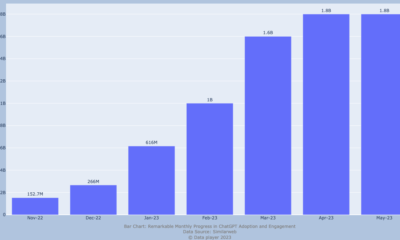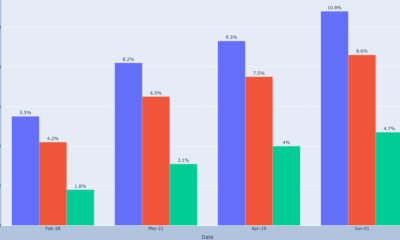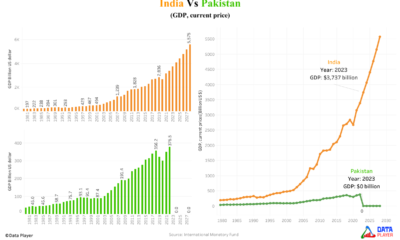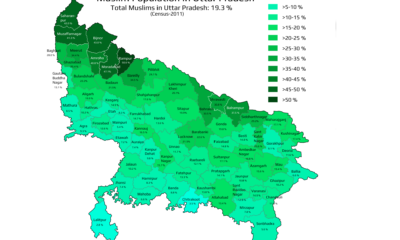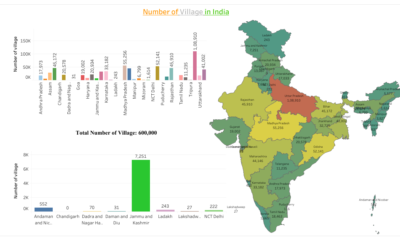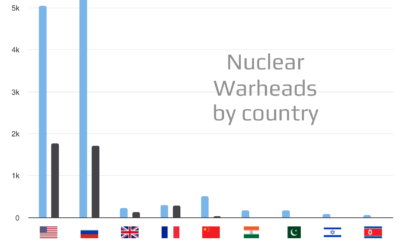Technology
How many Industries are using ChatGPT
Published
2 years agoon

Introduction
In today’s digital world, many businesses are using advanced technologies to improve their operations and enhance customer experiences. One such technology is ChatGPT, a smart language model developed by OpenAI. Here, we’ll explore how various industries are using ChatGPT to make their work easier and provide better services to their customers.
The above bar chart shows the number of companies that are started using ChatGPT for their businesses. Thera are 23 sectors where ChatGPT has been used. Lets discuss each and every points.
- Technical (251 organizations): ChatGPT is widely used in the technical sector. Over 250 organizations are using it to automate tasks, provide technical support, and create user-friendly interfaces for complex systems. This helps them work more efficiently and deliver better products and services.
- Education (209 organizations): In the education sector, ChatGPT is transforming the way students learn and teachers teach. More than 200 organizations are using it to create interactive learning materials, answer student questions, and provide personalized tutoring. This makes learning more engaging and accessible for students.
- Business Services (98 organizations): Nearly 100 organizations in the business services industry are benefiting from ChatGPT. They use it for tasks like customer support, lead generation, and data analysis. By automating these processes, businesses can save time and improve their services.
- Manufacturing (89 organizations): In manufacturing, ChatGPT is helping companies streamline their operations. Around 90 organizations are using it to optimize production processes, manage supply chains, and gather real-time insights. This improves productivity and ensures better quality control.
- Finance (44 organizations): The finance industry is also utilizing ChatGPT. About 40 organizations are using it for tasks like financial analysis, risk assessment, and fraud detection. ChatGPT helps process large amounts of data and provides valuable insights for making financial decisions.
- Retail (35 organizations): ChatGPT is making a difference in the retail sector as well. Around 35 organizations are using it to engage customers, offer personalized recommendations, and manage inventory. This improves the overall shopping experience and helps businesses increase sales.
- Healthcare (24 organizations): In the healthcare industry, ChatGPT plays a vital role. With 24 organizations employing it, ChatGPT aids in patient engagement, symptom analysis, and appointment scheduling. It helps healthcare providers deliver timely and personalized care to patients.
- Government (18 organizations): Government agencies are also adopting ChatGPT, with 18 organizations using it for various purposes. ChatGPT assists in citizen services, policy analysis, and public communication. It enables governments to engage with their constituents effectively.
- Media & Internet (17 organizations): In the media and internet sector, ChatGPT has gained traction. Seventeen organizations utilize ChatGPT for content generation, automated reporting, and personalized recommendations. It helps media companies deliver engaging content and improve user experiences.
- Construction (15 organizations): ChatGPT is making an impact in the construction industry as well. Fifteen organizations employ ChatGPT for project management, cost estimation, and design assistance. It streamlines construction processes and enhances collaboration among teams.
- Organizations (14 organizations): Internal communication and knowledge sharing are improved through ChatGPT in various organizations. With 14 organizations utilizing ChatGPT, it facilitates information retrieval, task management, and collaboration among employees.
- Telecommunications (13 organizations): ChatGPT is utilized by 13 organizations in the telecommunications industry. It aids in customer support, network monitoring, and service troubleshooting. ChatGPT ensures smooth communication and resolves technical issues promptly.
- Transportation (10 organizations): The transportation sector benefits from ChatGPT in multiple ways. Ten organizations employ ChatGPT for route optimization, logistics planning, and customer service. It helps streamline operations and improve overall efficiency.
- Entertainment (10 organizations): ChatGPT is enhancing the entertainment industry as well. Ten organizations are utilizing ChatGPT for content recommendations, interactive storytelling, and personalized experiences. It allows entertainment companies to engage with their audience in innovative ways.
- Consumer Services (10 organizations): In the consumer services sector, ChatGPT is making a difference. Ten organizations use ChatGPT for customer support, product recommendations, and personalized assistance. It improves customer satisfaction and fosters long-term relationships.
- Real Estate (9 organizations): ChatGPT is transforming the real estate industry, with nine organizations leveraging its capabilities. It aids in property search, virtual tours, and answering customer inquiries. ChatGPT enables real estate agents to provide comprehensive information to potential buyers.
- Insurance (9 organizations): The insurance industry benefits from ChatGPT as well. Nine organizations use ChatGPT for policy recommendations, claims processing, and customer assistance. It helps insurance companies streamline their operations and deliver better services.
- Hospitality (9 organizations): ChatGPT is revolutionizing the hospitality sector, with nine organizations incorporating it into their processes. It assists in personalized guest experiences, concierge services, and reservation management. ChatGPT enhances customer satisfaction and helps hotels and resorts deliver exceptional service.
- Energy, Utilities & Waste Treatment (9 organizations): ChatGPT plays a role in the energy, utilities, and waste treatment sector. Nine organizations utilize ChatGPT for energy consumption analysis, waste management optimization, and customer engagement. It aids in making environmentally conscious decisions and improving resource utilization.
- Wholesale (6 organizations): In the wholesale industry, ChatGPT is proving to be valuable. Six organizations leverage ChatGPT for inventory management, order processing, and customer inquiries. It streamlines wholesale operations and improves customer service.
- Law Firms & Legal Services (1 organization): ChatGPT is making its way into law firms and legal services. One organization employs ChatGPT for legal research, document analysis, and client communication. It assists lawyers in their work and enhances efficiency.
- Cultural (1 organization): The cultural sector benefits from ChatGPT as well. One organization uses ChatGPT for art curation, historical analysis, and interactive exhibits. It enhances cultural experiences and promotes engagement.
- Agriculture (1 organization): ChatGPT has also found its place in the agriculture industry. One organization utilizes ChatGPT for crop management, weather analysis, and pest control. It assists farmers in making informed decisions and optimizing agricultural practices.
Conclusion
ChatGPT’s impact is evident across a wide range of industries. From technology to education, finance to retail, and healthcare to transportation, organizations are leveraging ChatGPT’s capabilities to streamline processes, enhance customer experiences, and drive innovation. As ChatGPT continues to advance, we can expect ChatGPT to play an even bigger role in shaping how businesses operate and serve their customers in the future.
Where does the Data fetch from?
Data Source: Data for ChatGPT uses by Industries:2023 is fetched from Statista and Enterprise Apps Today. Several other information are taken from personnel research.
You may like
Technology
Highest number of software developers by country in the world 2023 by GitHub | Data Player
Published
1 year agoon
February 11, 2024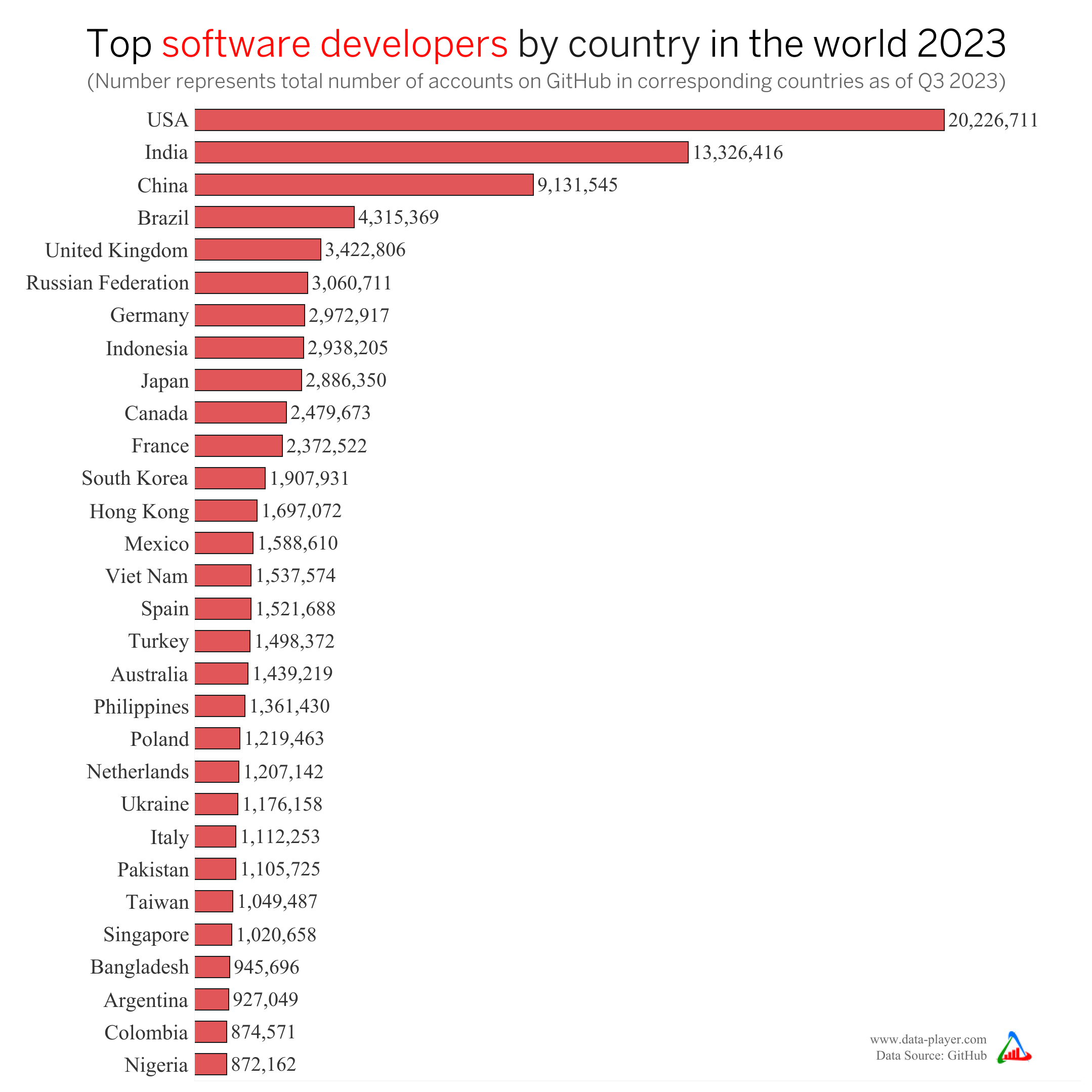
Interesting Facts
- GitHub, has published new data about number of developers around the world.
- The United States of America, India, and China have the largest number of developers.
- Saint Pierre and Miquelon, Cook Islands and The Holy See are the three countries that have least number of developers with 140, 142 and 157 respectively.
Overview on GitHub
GitHub (a repository) is a cloud based service, a leading platform for developers, providing a wide range of tools and services. It allows developers to easily create, store, manage, and share their code with others. This platform fosters collaboration and productivity among developers, driving innovation in the field of computer science and beyond. In essence, GitHub simplifies the process of using Git for version control and collaboration, making it more accessible and efficient for both individuals and teams. GitHub’s user-friendly interface extends its utility beyond software development, with some individuals leveraging it to manage various projects, such as writing books. GitHub’s free signup option allows anyone to host a public code repository, making it particularly attractive for open-source projects and fostering a vibrant community of collaboration and innovation[3].
In this article, our focus will be on the global usage of GitHub among developers in their day-to-day activities. We’ll delve into the statistics and trends regarding the number of developers from different countries who rely on GitHub for writing, sharing, and storing their code. Additionally, we’ll explore how developers leverage GitHub to build and enhance their professional profiles, ultimately enhancing their prospects in the job market. By examining the geographical distribution of GitHub users and their usage patterns, we aim to provide insights into its role as a fundamental tool in the careers of developers worldwide.
Developers around the world
Based on above GitHub’s data, the worldwide developer community has exceeded 125 million members in 2023. Notably, the United States, India, and China constitute more than 39.12% of this total. This statistic underscores the substantial presence of software developers in these countries, reflecting their pivotal role in shaping the global technology ecosystem.
The number of developers worldwide has risen significantly, from over 105 million in 2022 to now exceeding 125 million in 2023. This growth suggests a steady increase in people joining the developer community. Additionally, there’s a growing popularity of programming languages like JavaScript, Python, Java, R, C/C++, C#, etc. This indicates a wider interest in software development and highlights the diverse range of tools developers use to create programs and applications.
Developers create their profiles on GitHub, where they showcase their coding projects and contributions. They often include their GitHub profile links on their resumes to demonstrate their skills to potential employers. This practice highlights the growing importance of technology in today’s job market, as more developers seek to showcase their abilities and stay connected with the global developer community.
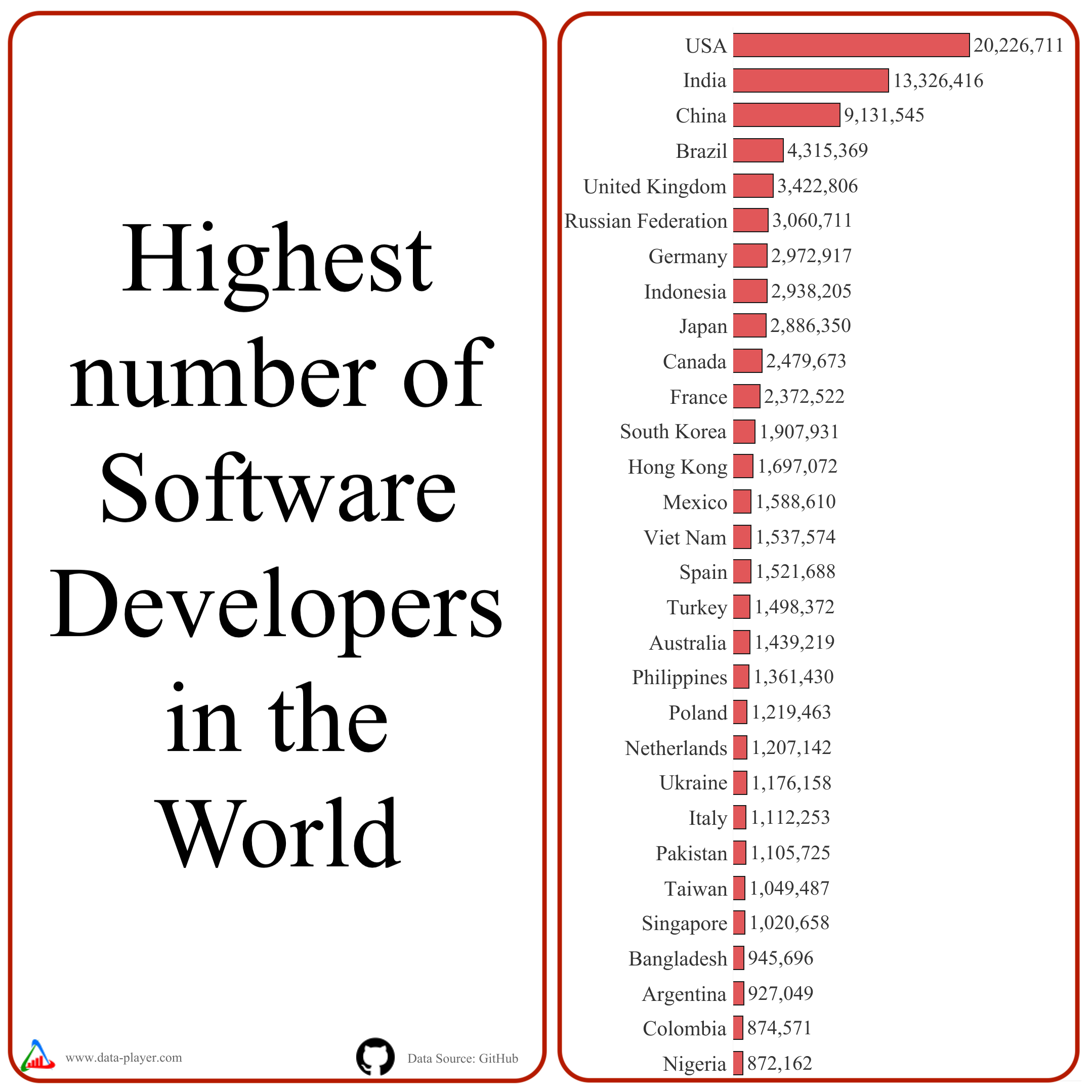
India is known for producing a large number of skilled software engineers who are well-trained in various technologies and programming languages. These engineers are highly sought after by companies worldwide and play a significant role in advancing technology globally. Their expertise helps boost the technology sector in different countries, making a valuable contribution to innovation and development[4]. Next in line are China, Brazil, the United Kingdom, and Russia, each boasting substantial numbers of software developers. Specifically, they have 9.1+ million, 4.3+ million, 3.4+ million, and 3+ million software developers, respectively. It’s no surprise that the USA tops the charts on GitHub for having the largest number of developers worldwide. This is largely due to the fact that many major tech companies are headquartered in the USA, attracting a large pool of talented developers to the country.
Data Source + –
Tools + –
- Jupyter Notebook: It is used to structure the data frame to look like above table. We have used pandas as a library in jupyter notebook where it uses python programming for data wrangling.
- Tableau: For visualization purposes, Tableau was utilized to create the dashboard showcased above. The dashboard includes a bar chart complemented by images and texts to enhance data representation and interpretation.
Bibliography + –
IBAN, COUNTRY CODES ALPHA-2 & ALPHA-3, December 21, (2022). Available at: https://www.iban.com/country-codes (Accessed 25 January 2024).
GitHub, Innovationgraph, (January 2024). Available at: https://github.com/github/innovationgraph/blob/main/data/developers.csv (Accessed 7 Feruary 2024).
Kinsta What Is GitHub? A Beginner’s Introduction to GitHub, (November 17, 2023). Available at: https://kinsta.com/knowledgebase/what-is-github/ (Accessed 9 February 2024).
M. Megha, Top destinations with the highest number of software developers,, (January 26, 2022). Available at: https://thescalers.com/top-destinations-with-the-highest-number-of-software-developers/ (Accessed 26 January 2024).
Technology
Remarkable Monthly Progress in ChatGPT Adoption and Engagement
Published
2 years agoon
July 1, 2023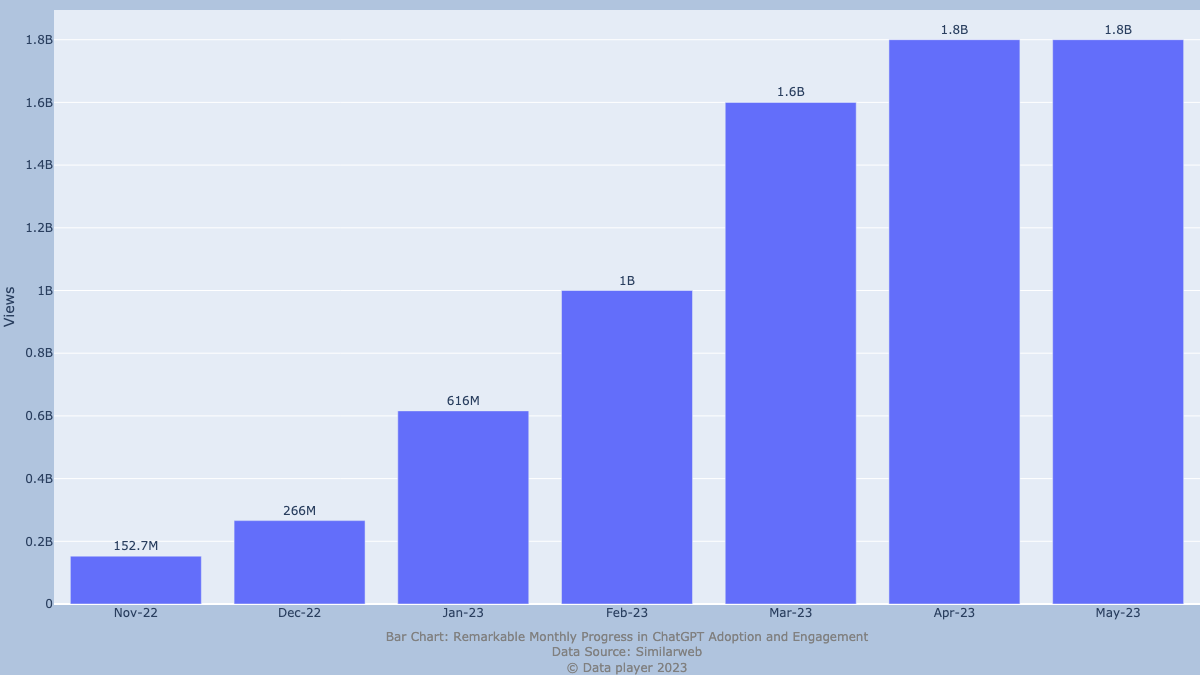
Introduction
In today’s tech-savvy world, ChatGPT has become a go-to choice for chatting with computers. It can understand and respond to our questions just like we’re having a conversation with a real person. ChatGPT’s popularity has skyrocketed, and in this, we’ll explore the incredible increment in monthly views from November 2022 to May 2023. It’s amazing to see how more and more people are relying on ChatGPT all around the globe.
Analysis of the above bar chart
- November 2022: The viewership of ChatGPT started with a substantial count of 152.7 million views, indicating a positive reception from users during its initial launch.
- December 2022: The views experienced a significant surge, reaching 266 million, suggesting an increase in user interest and engagement.
- January 2023: ChatGPT continued to gain momentum, with views soaring to 616 million, reflecting a growing user base and heightened curiosity.
- February 2023: The viewership crossed the billion mark, reaching a staggering 1 billion views. This milestone signifies ChatGPT’s widespread adoption and popularity among users.
- March 2023: The popularity of ChatGPT continued to soar, with views reaching an impressive 1.6 billion. The substantial growth indicates sustained interest and engagement from users.
- April 2023: The viewership witnessed further growth, surpassing the 1.8 billion mark. This milestone reflects a sustained and expanding user base, solidifying ChatGPT’s position as a prominent conversational AI platform.
- May 2023: The viewership remained consistently high at 1.8 billion views, maintaining the strong user engagement and interest observed in the previous month.
The monthly views of ChatGPT exhibited consistent growth and an upward trend throughout the analyzed period and it can be clearly seen by above line chart. The exponential increase in viewership from November 2022 to May 2023 showcases the rapid adoption and acceptance of ChatGPT among users. The consecutive months of high viewership indicate a sustained interest in and reliance on ChatGPT as a valuable conversational AI tool.
Why People are engaging more with ChatGPT every month
- More and more people are learning about ChatGPT and realizing how useful it can be for various tasks. As awareness spreads, more individuals and businesses are using ChatGPT, which leads to higher viewership.
- Over time, ChatGPT has been getting better at what it does. It has become more accurate and effective, which makes people trust and use it more, resulting in increased viewership.
- When people have a good experience with ChatGPT, they tend to tell others about it. Positive reviews and recommendations help spread the word, and as a result, more people start using ChatGPT, contributing to its growing viewership.
- ChatGPT is versatile and can be used in various industries and sectors. This wide applicability attracts users from different fields, leading to increased viewership as more people find value in utilizing ChatGPT for their specific needs.
- The technology behind ChatGPT, called natural language processing and machine learning, keeps improving. These advancements make ChatGPT more efficient and accurate, making it even more appealing to users and resulting in a rise in viewership.
- The developers of ChatGPT continuously update and improve the system. They fix bugs and provide technical support, which builds trust and confidence in the platform. Users appreciate the ongoing support, making them more likely to use ChatGPT and contribute to its growing viewership.
Conclusion
The monthly viewership data highlights the impressive growth and popularity of ChatGPT within a short span of time. The exponential increase in views from November 2022 to May 2023 signifies the successful integration of ChatGPT into various applications and industries, as well as its increasing importance in meeting the conversational needs of users worldwide.
As ChatGPT continues to evolve and adapt to user requirements, its viewership is expected to experience further growth and reach new milestones in the future.
Technology
Global Workplace Adoption of ChatGPT: February-June 2023
Published
2 years agoon
June 30, 2023
Certainly! Artificial intelligence chatbots have been rapidly evolving and gaining popularity in recent years. ChatGPT, has indeed made a significant impact on how people use AI-powered language models in the workplace. Its ability to understand and generate human-like text has enabled various applications and use cases. Employees have recently initiated the utilization of ChatGPT within their respective companies, willingly inputting sensitive company data into the system, despite their awareness that ChatGPT, being an AI chatbot, has the capability to learn from and potentially disclose such sensitive information to external parties or organizations.
The bar chart above shows the percentage of employees worldwide who have been using ChatGPT in their companies. It indicates the number of employees who have shared company data, shared confidential information, and the specific date on which these actions occurred.
The following is the data of the above bar chart.
- February 28, 2023: 5.5% of employees have used ChatGPT at work, 4.2% have pasted any company data, and 1.8% have pasted confidential data.
- March 21, 2023: 8.2% of employees have used ChatGPT at work, 6.5% have pasted any company data, and 3.1% have pasted confidential data.
- April 19, 2023: 9.3% of employees have used ChatGPT at work, 7.5% have pasted any company data, and 4% have pasted confidential data.
- June 1, 2023: 10.8% of employees have used ChatGPT at work, 8.6% have pasted any company data, and 4.7% have pasted confidential data.
Explanation of Bar Chart
The bar chart indicates a gradual increase in the usage of ChatGPT by employees in the workplace from February to June. The percentage of employees using ChatGPT at work has risen from 5.5% in February to 10.8% in June. Similarly, the percentages of employees who have shared any company data and confidential information have also shown an upward trend, increasing from 4.2% to 8.6% and from 1.8% to 4.7%, respectively, during the same period. This suggests a growing acceptance and engagement with ChatGPT among employees, potentially leading to increased sharing of company-related information and confidential data which may lead to breach the company security and policies and may harmful for company’s businesses.
Disadvantages of using ChatGPT at workplace
From the above data, there are a few potential drawbacks or concerns that can be identified:
- Data Security Risks: Sharing company data and confidential information with ChatGPT can lead to risks in keeping that information safe. It’s important to be cautious about protecting sensitive data from unauthorized access or breaches.
- Lack of Awareness: Some employees may not fully understand the risks of sharing sensitive data with an AI chatbot like ChatGPT. It’s important to educate employees about the potential risks and consequences to avoid any unintended data leaks.
- Potential for Data Leakage: The increased sharing of company data and confidential information can increase the chances of unintentional data leaks or sharing of sensitive information with unintended recipients. This can jeopardize data privacy and confidentiality.
- Compliance and Regulatory Issues: Depending on the nature of the shared data and the regulations that apply, there is a possibility of not complying with data protection regulations. It’s important to ensure that sharing company data with ChatGPT aligns with legal requirements.
- Insider Threats: The data indicates that some employees are sharing company and confidential data. This raises concerns about the potential for internal employees intentionally or accidentally exposing sensitive information, which can harm the company’s reputation and financial standing.
Advantages of using ChatGPT at Workplace
- More employees are using ChatGPT at work, which shows that they are accepting and adopting this AI chatbot technology. This can help make work processes more efficient and productive.
- Employees can share company data with ChatGPT as long as the data is not confidential, which allows for better knowledge sharing and collaboration among colleagues. This means employees can benefit from the information generated by the chatbot, making them more informed and knowledgeable.
- By using ChatGPT, employees can save time and resources. They can quickly get answers to common questions without having to spend a lot of time researching or asking others for help.
- ChatGPT can help employees make better decisions by analyzing the shared company data and providing valuable insights. This data-driven approach can support more informed decision-making.
- ChatGPT acts as a virtual assistant, providing immediate assistance and guidance to employees. This makes workflows more efficient, helps employees find information faster, and resolves queries more quickly.
- Using ChatGPT allows organizations to scale their support capabilities without needing to hire more people. This is especially helpful during busy periods or when there is a high volume of inquiries.
Conclusion
Using ChatGPT at work has its good and not-so-good sides. The good parts include things like getting work done faster, sharing knowledge with coworkers, and making better decisions. It can also save time and help employees feel more involved. However, there are some things to watch out for. Sharing sensitive company information with ChatGPT can be risky if it’s not protected properly. Some employees might not realize this risk or understand the rules. There’s also a chance that information could be shared by mistake or with the wrong people, which could cause problems. It’s important for companies to take steps to keep data safe, train employees about the risks, and follow the rules. By doing these things, companies can enjoy the benefits of ChatGPT while keeping their information secure.
Where does the Data fetch from?
Data Source: Data for adoption of ChatGPT at workplace: Febuary 2023 to June 2023 is fetched from Statista. Several other information are taken from personnel research.
Trending

 Economy2 years ago
Economy2 years agoWhy Pakistan’s economy is drowning while India’s economy is touching the sky

 Technology1 year ago
Technology1 year agoHighest number of software developers by country in the world 2023 by GitHub | Data Player

 Religion9 months ago
Religion9 months agoMapped: What are the muslims population in Uttar Pradesh | State of India

 Demographics10 months ago
Demographics10 months agoMapped: Average Working Hours by European Countries in 2024

 Demographics2 years ago
Demographics2 years agoWhat are the Number of Villages in India by its State and Union Territory

 Superpower countries9 months ago
Superpower countries9 months agoGlobal Nuclear Warhead Distribution by Nation 2024

 Demographics2 years ago
Demographics2 years agoMassive population size by Indian states 2023

 Religion1 year ago
Religion1 year agoWorld’s Largest Religion in 2024 | Data Player

